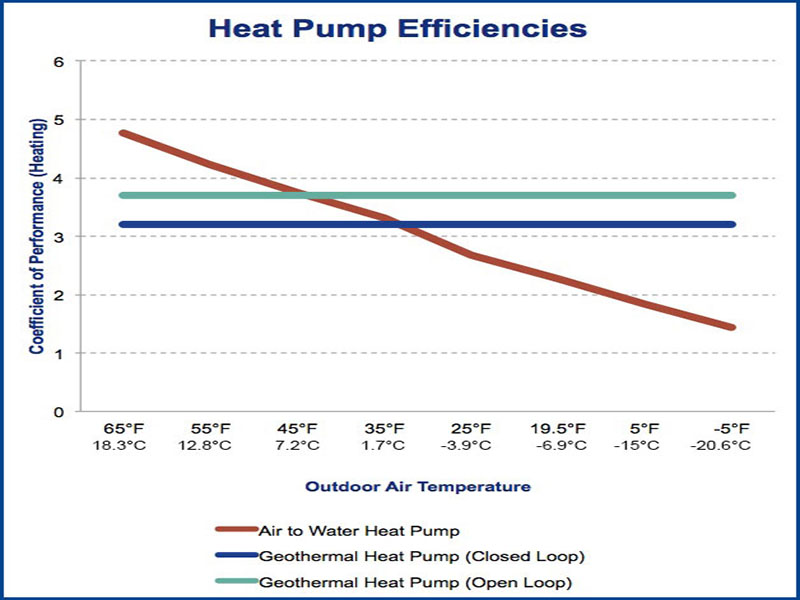Air Source & Geothermal Heat Pump Effective Temperature Range
While our air source heat pumps will operate down to -4°F (-20°C), the colder the outdoor air, the harder the heat pump will have to work to produce heat for your home. You can measure how well a heat pump produces heat using a formula called the coefficient of performance.
The coefficient of performance essentially measures how much energy output is produced for a specific energy input and expresses it as a number. For example, if a heat pump requires 1 watt of energy in to produce 4 watts of energy out, it would have a COP or 4/1 or 4.0. The extra three watts of energy come from either the air (for air source heat pumps) or the earth (for geothermal heat pumps). You can find more detailed explanation of heat pump COP at the link.
Geothermal heat pumps have a steady COP because their heat source (the ground) never fluctuates in temperature. The ground always maintains a constant temperature, no matter how cold or hot it is outside. This stable heat source makes geothermal heat pumps the ultimate cold weather heat pump, but air source heat pumps can still get the job done. Air source heat pumps have a fluctuating COP because their heat source (the air) fluctuates as the season changes.
To help take some of the mystery out of these fluctuating COPs and give you a sense of the heat pump effective temperature range and efficiencies at freezing outdoor temperatures, we’ve mapped how our heat pumps perform at different temperatures.

The data above was taken from an ATW-65 and the equivalent geothermal heat pump (W-65) on both an open and closed geothermal ground loop.
As you can see, the warmer the outdoor air, the better the air source heat pump performs. As the outdoor air temperature drops, the heat pump needs to work harder, so it becomes less efficient. The COP continues to drop until we reach an outdoor temperature of -4°F (-20°C). -4°F is the lower limit of our air source heat pump effective temperature range. In temperatures lower than that the heat pump shuts down and electric backup heat takes over. The backup heat protects the compressor and preserves the longevity of the machine. The backup heat may also come on periodically in warmer temperatures if the heat pump alone cannot satisfy your home’s heat load. Electric backup heat has a COP of 1.0.
You’ll also notice that the geothermal heat pump lines are higher and remain constant. That’s because the ground does not fluctuate in temperature the way the outdoor air does, so a geothermal heat pump will never lose efficiency (except in extreme cases), and never needs backup heat. Air source heat pumps can be optimized to perform cold weather heating, but geothermal heat pumps will always be the ultimate cold weather heat pump.
Remark:
If you‘re interesting in heat pump products,please feel free to contact OSB heat pump.
Some of the articles are taken from the Internet. If there is any infringement, please contact us to delete it.

